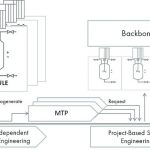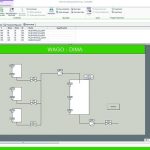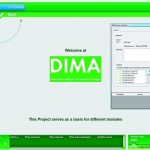In the process industry, the demand for system designs with significantly greater production flexibility is steadily rising. To address this, Wago developed Dima (Decentralised Intelligence for Modular Applications), a method that endows modular systems with an equally modular automation architecture to provide system adaptation within just a few minutes.
Dima adapts production processes
System installation and modification in record time
In the process industry, the demand for system designs with significantly greater production flexibility is steadily rising. To address this, Wago developed Dima (Decentralised Intelligence for Modular Applications), a method that endows modular systems with an equally modular automation architecture to provide system adaptation within just a few minutes.
The trajectory of the process industry is essentially shaped by two factors: globalisation and customisation. Globalisation currently allows anyone, anywhere, to order goods from anywhere else in the world. Customisation is surging throughout the entire consumer goods industry, from food to pharmaceuticals and even the medical sector. Take mymuesli.com, a highly regarded European start-up, for example. The firm’s products have become breakfast staples because consumers can go online to create truly customised muesli blends. More than five billion possible blends are bound for dining room tables in the UK, France and Germany, making mymuesli.com emblematic of the globalisation and customisation trends which are revolutionising the process industry.
Adapting production processes
Unsurprisingly, these trends represent an enormous challenge for the process industry – customised products cannot be scheduled for production in the way their mass-produced counterparts are. Compounding this difficulty are shorter product life cycles that further complicate planning and require a faster time to market. Historically, exceptional system reliability has long been the top demand from the process industry; however, recent trends have made process flexibility the deciding criterion. By definition, this trend also often calls for the abandonment of existing premises for system design: process systems are – or used to be – primarily single-source systems. Designed by engineers using the top-down approach, these systems were optimised to provide the greatest yield while minimising the use of raw materials and exhibiting low energy losses. A comparatively long design phase and complex system construction using convoluted material flows were widely accepted as part of the process. However, there is a steadily increasing demand for systems that can manufacture numerous product variants on a single production line, exchange individual modules as needed or seamlessly increase product yield by numbering up without affecting the overall system. What is required is a production process that keeps pace with the dynamics of the market. However, this not only places new demands on a system’s physical structure; the automation system is taxed as well.
Modular system automation
The automation system must be quickly adapted to the new physical and functional production structure after a modification. A “plug-and-produce” solution – including functionally independent modules controlled via a standardised interface – would be helpful in minimising programming during, or after, any modifications to a production plant. This solution would allow complete adaptation of the system in just a few minutes – with no extra programming involved.
This prompted Wago to develop Dima as a vendor-independent method which made its debut at the 2014 Namur Annual General Meeting. Dima enables modular automation structures to be established in the process industry. The centrepiece of Dima is the Module Type Package (MTP). This is a new form of description for application modules containing all information necessary to integrate these modules into a process control level. Amongst other things, the MTP includes its own process engineering function, which can be offered by the module via services. To integrate the application module, the MTP is imported into the process control system; its process engineering services are then orchestrated by a batch tool to obtain a complete process.
Dima system prototype
To demonstrate the viability of Dima, Wago developed a modular system demonstrator in cooperation with Dresden University of Technology and Helmut Schmidt University of Hamburg. This Dima system prototype consists of the four process steps: mixing, distilling, filtering and bottling.
Each of these four basic functions is represented by a separate module. The application’s automation system was implemented using two software tools:
- Module engineering and MTP generation with Wago’s e!Cockpit engineering tool and
- System engineering, including MTP import and processing, in Copa-Data’s Zenon process control system
Each of the four Dima-equipped application modules features its own Wago controller that supervises all processes within the module, including communication with field devices using various protocols, monitoring interlocks and calculations of internal control circuits. The controllers are programmed using Wago’s e!Cockpit engineering software. This allows the module manufacturer to generate the MTP automatically from the source code of the module controller and to select and export customised services and operating screens. Thanks to this selection function, operators can amass an extensive library of reusable functions. Furthermore, each application module has its own control panel, so that it can be independently parameterised and diagnosed.
To integrate the application module into the process control level, the MTP is imported into Copa-Data’s Zenon process control system. The information modelled in the MTP is all that is needed for the module integration process. All the required variables, operating screens, basic operations and links are created during the MTP import. The appropriate OPC UA driver can also be created in the process control system and should simply be completed with the address of the module concerned. This facilitates direct communication between the control system and the module controller immediately after activating the process control system’s runtime. The production system is ready for use within minutes.
Wago first debuted a working Dima prototype at the SPS/IPC/Drives fair. The application’s integration engineering, the numbering-up of individual application modules and the procedure for exchanging these modules were demonstrated by Wago with the filter module’s connection and disconnection techniques. Both the complete removal of the filter module and the subsequent restart of the production process were performed in just 2.5 minutes.
www.cpp-net.com search: cpp0216wago
Thomas Holm
Thomas Holm
Market ManagementIndustrie & Process,Wago
Share:










